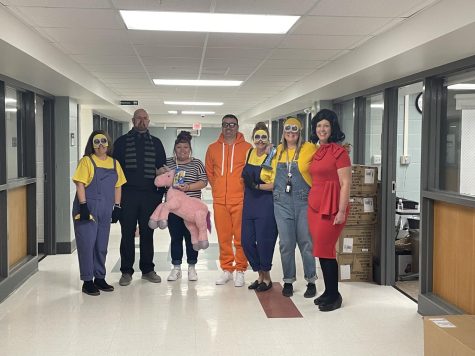Alone in the Crowd
BHS administration speaks out against the bullying incident on September 8th.
A student walks out the door and into the bustling hallway, ready to move on to the next class, not expecting a premeditated attack against him. Immediately, the classmate is pulled, shoved and threatened, a physical act of violence is growing but bystanders don’t speak or move. How many thoughts run through their minds? How many more people will pass by, deeming the event unworthy of the turn of their heads? In that moment, even though the hall is full of people, the student is alone.
After a bullying incident between two male students on September 8th, a school-wide assembly took place the following Monday morning where Principal Jeremy Sirois addressed the high school’s position on violence.
“Let me be clear,” said Sirois in his speech. “If you get physical with somebody, you are gone. If you videotape an altercation, you are gone. If you are a bystander egging it on, you are gone. Hate has no place in this building.”
Guidance counselor Jennifer Rowland explained that this was different bullying than that of the past; it was a planned and physical attack.
“That’s one piece of it,” said Rowland. The other is that you have people not doing anything about it, it’s disheartening that anyone would just sit back and watch an incident like that.”
Though this was a big event, many students were not aware of it. In fact, the altercation was hardly visible to the people present. Bystanders may not have realized what was happening in time to help or didn’t know what to do in the first place.
“When an instance gets to that point, a lot of times kids’ first reactions are just to stand and watch,” said Sirois. “They don’t want to get involved or they think that it’s amusing to watch.”
During the assembly, Sirois urged everyone to have the courage to stand up and defend those in trouble.
“You don’t have to get in there and fight, all you gotta do is try to make a difference; it doesn’t take much to be kind,” Sirois said.
Not many students may find it a pleasure to be involved in somebody else’s drama. If an individual doesn’t know the people fighting, they might wonder why should they be the ones to help?
“[If students just watch the bullying and not tell anyone] then what does that say about them?” said Rowland. “From an adult’s perspective, why would you want to be that person that sits back and just watches someone else be so hurt? Bullying is so hurtful and so stressful. Most kids have been bullied at some point or another and understand how that feels.”
The attack was videotaped and posted on Instagram, then shared on multiple social media platforms causing it to go viral with thousands of views in the span of two days, which–according to the Maine state law–classifies it as both an act of physical violence and cyberbullying.
“If people want some direction on how to handle a conflict like that, if they just want someone to tell them what to do or talk them through it in case it ever happens, I think we can absolutely make that available to them,” said Rowland. “Get a teacher or an administrator, there’s constantly people in the hallways. Get someone right away to let the right people know so they can stop it.”
Although a case of physical violence is uncommon, cyberbullying is an everyday occurrence for many people. School Resource Officer Paul Rondeau explained that cyberbullying in the law book is considered harassment.
“It’s too easy to hide in the internet,” said Rondeau. “People say things to other[s] that they wouldn’t usually say or communicate face to face; they feel like there’s this wall–this barrier that protects them.”
Rondeau adds that even though the user may think they’re anonymous in creating fake accounts or sending pictures, there’s a way to investigate and track down what people are uploading.
“Regardless of where it [pictures/posts] may be going, it is traceable. Even [if] you don’t have your name or a ton of information attached, it’s traceable,” Rondeau said.
According to Sirois, most drama originates outside of school, but the fallout is brought into the school environment and left to the hands of administrators.
“I don’t think it [bullying] is any bigger now than when it first started; I just think the power of electronics makes it more difficult and makes it seem like it’s growing,” Sirois said.
He also encourages students to tell administrators what exactly is affecting them so they can investigate and find the source.
“We can’t help unless we know,” said Sirois. “It takes courage to do that, but they also have to trust that it’s our job to try to make things better.”
Rondeau points out that there are countless problems that branch off of attempts to resolve disagreements online and people love that drama.
“Nobody likes to get picked on,” said Rondeau. “Regardless of what people may think of others, none of them know what that person is walking through on a daily basis; nobody knows what they go home and face.”
In the video of the attack, another student sees what is happening and—while not knowing any of the people involved—stops the fight. Someone in the busy hallway decided to help a classmate who was alone amongst the crowd.
“Treat people the way that you wouldn’t mind being treated,” said Rondeau. “I think if everybody would just try to remember that, it would make for a much happier place.”








